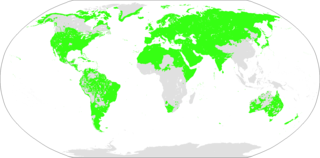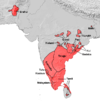
The Dravidian languages are a language family spoken by more than 215 million people, mainly in southern India and northern Sri Lanka, with pockets elsewhere in South Asia. Since the colonial era, there have been small but significant immigrant communities outside South Asia in Mauritius, Hong Kong, Singapore, Malaysia, Indonesia, Philippines, Britain, Australia, France, Canada, Germany and the United States.
Dravidian, Dravidan, or Dravida may refer to:

Nostratic is a controversial and hypothetical macrofamily, which includes many of the indigenous language families of Eurasia, although its exact composition and structure vary among proponents. It typically comprises Kartvelian, Indo-European and Uralic languages; some languages from the disputed Altaic family; the Afroasiatic languages spoken in North Africa, the Horn of Africa, the Arabian Peninsula and the Near East as well as the Dravidian languages of the Indian Subcontinent.

Tamil is a Dravidian language natively spoken by the Tamil people of South Asia. Tamil is the official language of the Indian state of Tamil Nadu, as well as two sovereign nations, Singapore and Sri Lanka. In India, it is also the official language of the Union Territory of Puducherry. Tamil is spoken by significant minorities in the four other South Indian states of Kerala, Karnataka, Andhra Pradesh and Telangana and the Union Territory of the Andaman and Nicobar Islands. It is also spoken by the Tamil diaspora found in many countries, including Malaysia, South Africa, United Kingdom, United States, Canada, and Australia. Tamil is also natively spoken by Sri Lankan Moors.

The Uralic languages form a language family of 38 languages spoken by approximately 25 million people, predominantly in Northern Eurasia. The Uralic languages with the most native speakers are Hungarian, Finnish and Estonian, while other significant languages are Erzya, Moksha, Mari, Udmurt, Sami and Komi, spoken in northern regions of Scandinavia and the Russian Federation.

Telugu is a Dravidian language spoken by Telugu people predominantly living in the Indian states of Andhra Pradesh, Telangana and Yanam district of Puducherry, India, where it is also the official language. It stands alongside Hindi and Bengali as one of the few languages with primary official language status in more than one Indian state. Telugu is also a linguistic minority in the states of Odisha, Karnataka, Tamil Nadu, Kerala, Punjab, Chhattisgarh, Maharashtra and Andaman and Nicobar Islands. It is one of six languages designated a classical language of India by the country's government.

Tulu is an endangered Dravidian language whose speakers are concentrated in two coastal districts of Karnataka in southwestern India, and in a part of the Kasaragod district of Kerala. The native speakers of Tulu are referred to as Tuluva or Tulu people and the geographical area is unofficially called as Tulu Nadu.
The Elamo-Dravidian language family is a hypothesised language family that links the Dravidian languages of India to the extinct Elamite language of ancient Elam. Linguist David McAlpin has been a chief proponent of the Elamo-Dravidian hypothesis. The hypothesis has gained attention in academic circles, but has been subject to serious criticism by linguists, and remains only one of several scenarios for the origins of the Dravidian languages. Elamite is generally accepted by scholars to be a language isolate, unrelated to any other known language.
Proto-Dravidian is the linguistic reconstruction of the common ancestor of the Dravidian languages. It is thought to have differentiated into Proto-North Dravidian, Proto-Central Dravidian, and Proto-South Dravidian, although the date of diversification is still debated.
Irula is a Dravidian language spoken by the Irulas who inhabit the area of the Nilgiri mountains, in the states of Tamil Nadu and Karnataka, India. It is written in the Tamil script.

The languages of India are divided into various language families, of which the Indo-Aryan and the are the most widely spoken. There are also many languages belonging to unrelated language families such as Austroasiatic and Sino-Tibetan, spoken by smaller groups. Linguistic records begin with the appearance of the Brāhmī script from about the 3rd century BCE.
Brahmin Tamil is the name of a dialect of Tamil traditionally spoken by Tamil Brahmins. The dialect, largely, uses Classical Tamil along with a heavy proportion of Sanskrit derivatives. According to linguist V Balasubramaniam, Brahmin Tamil dialect is closest to the Central Tamil dialect, particularly, the variant spoken by the once dominant and highly educated community colloquial spoken Tamil of Vellalars and Mudaliyars.
Vedic Sanskrit has a number of linguistic features which are alien to most other Indo-European languages. Prominent examples include: phonologically, the introduction of retroflexes, which alternate with dentals, and morphologically, the formation of gerunds; Some philologists attribute such features, as well as the presence of non-Indo-European vocabulary, to a local substratum of languages encountered by Indo-Aryan peoples in Central Asia and within the Indian subcontinent, including the Dravidian languages.
Kota is a language of the Dravidian language family with about 9000 native speakers in the Nilgiri hills of Tamil Nadu state, India. It is spoken mainly by the tribal Kota people. In the late 19th century, the native speaking population was about 1,100. In 1990, the population was only 930, out of an ethnic population of perhaps 1,400, despite the great increase in the population of the area. The language is 'critically endangered' due to the greater social status of neighbouring languages. The Kota language may have originated from Tamil-Kannada and is closely related to Toda. The Kota population is about 2500. The origin of the name Kota is derived from the Dravidian root word 'Ko' meaning Mountain.

Dravidian people or Dravidians are a linguistic group originating in South Asia who predominantly speak any of the Dravidian languages. There are around 245 million native speakers of Dravidian languages. Dravidian speakers form the majority of the population of South India and are natively found in India, Pakistan, Afghanistan, Bangladesh, the Maldives, Nepal, Bhutan and Sri Lanka. Dravidians are also present in Singapore or the United Arab Emirates through recent migration.
The Harappan language is the unknown language or languages of the Bronze Age Harappan civilization. The language being unattested in any readable contemporary source, hypotheses regarding its nature are reduced to purported loanwords and substratum influence, notably the substratum in Vedic Sanskrit and a few terms recorded in Sumerian cuneiform, in conjunction with analyses of the undeciphered Indus script.

The peopling of India refers to the migration of Homo sapiens into the Indian subcontinent. Anatomically modern humans settled India in multiple waves of early migrations, over tens of millennia. The first migrants came with the Coastal Migration/ Southern Dispersal 65,000 years ago, whereafter complex migrations within south and southeast Asia took place. West Eurasian hunter-gatherers migrated to South Asia after the latest Ice Age, but before the onset of farming. Together with a minor number of ancient South Asian hunter-gatherers they formed the population of the Indus Valley Civilisation (IVC).
Kannada dialects, in the broad sense incorporating the Kannada–Badaga languages, are spoken in and around Karnataka. Apart from literary Kannada, used in TV, news and literature, there are many spoken dialects.
Franklin C. Southworth is an American linguist and Professor Emeritus of South Asian linguistics at the University of Pennsylvania.
Malaysian Tamil, also known as Malaya Tamil, is a local variant of the Tamil language spoken in Malaysia. It is one of the languages of education in Malaysia, along with English, Malay and Mandarin. There are many differences in vocabulary between Malaysian Tamil and Indian Tamil.









